July 31, 2020
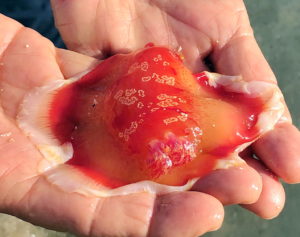
The back of one of our larger Spanish dancers. The collapsed gills are at the rear of the animal, the lower part of the picture.
During several early morning beach walks last week, my friends and I found Spanish dancers stranded in the sand. Even though the sea slugs were smallish youngsters, their bright red bodies surrounded by frilly yellow or white “skirts” were easy to spot. And to our delight, the five we found were alive, turning our walks into rescue missions.
Spanish dancers are the royalty of sea slugs, being big, beautiful and bountiful. Hawaii hosts two species, one growing to 8 inches long, the other to 12 inches.
These creatures are a sight to behold, whether twisting in the palm of my hand, grazing on sponges on the ocean floor, or swimming in the water column. Spanish dancers swim by flexing their bodies and flapping their margins, earning them their colorful common name.
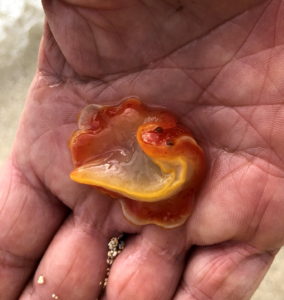
This is the underside of one of our smaller Spanish dancers. You can see its two tentacles (they resemble eyes in this picture) as the animal tries to turn over.
The scientific name of this large group of sea slugs is nudibranch, meaning naked gills. The name comes from a circle of feathery gills on their backs, toward the rear, looking like a tiny bouquet of flowers.
At the front, nudibranchs have a pair of tentacles that guide them to their food sources, such as sponges, hydroids (jellyfish relatives), corals, or other sea slugs. These stinging diets make sea slugs toxic to predators, their bright colors being a warning: Bite me and die.
Sea slugs are a treat for us snorkelers. Because sea slugs have few enemies, they often move about in the open, allowing us to admire and photograph their lovely colors and patterns.
After finding so many Spanish dancers on the beach, I went back to the water with mask and snorkel to see if they might be abundant on the nearby reef. I saw none. But I know at least five little ones are out there somewhere. When we waded out and returned them to the water, the youngsters flapped their fancy folds and swam away.
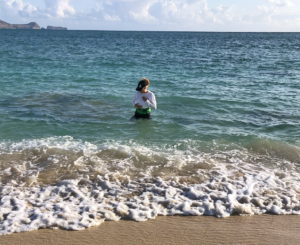
Friend, Michelle Hester, returning one of the Spanish dancers to the ocean. Mind the break, Tiny Dancer.
Much as I love exploring foreign reefs and distant oceans, last year I was wondering if I should travel a bit less. The pandemic made that decision for me, and although I miss our sailboat Honu, waiting in Australia for Craig and me, I’ve discovered that my inclination to stay in Hawaii for a while was a good one. I’m thoroughly enjoying this marvelous island that I’m lucky enough to call home.
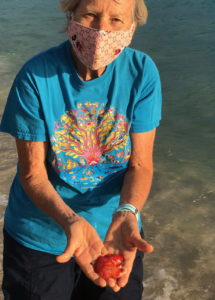
Me enjoying my beach find.
Part of my joy in living here is the migratory shorebirds, called Kolea, that also call Hawaii home. (I think of Hawaii as the plovers’ home since they spend about 9 months of the year here.) Our Kolea arrived from Alaska July 25th, as did several other early birds. To read my update about this year’s, and past summers’, plover return dates, go to www.koleacount.org. Scroll down the Home page to RECENT NEWS or see tab RESOURCES/NEWS.
When your Kolea returns, please add it to the REPORT page at that site.
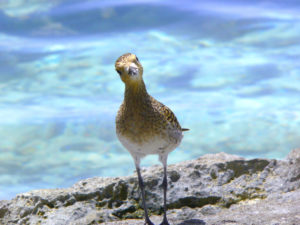
Every Kolea counts. Stay tuned for details about this winter’s Kolea Count, sponsored by the Hawaii Audubon Society. I’ll post information both here and on the Kolea site.